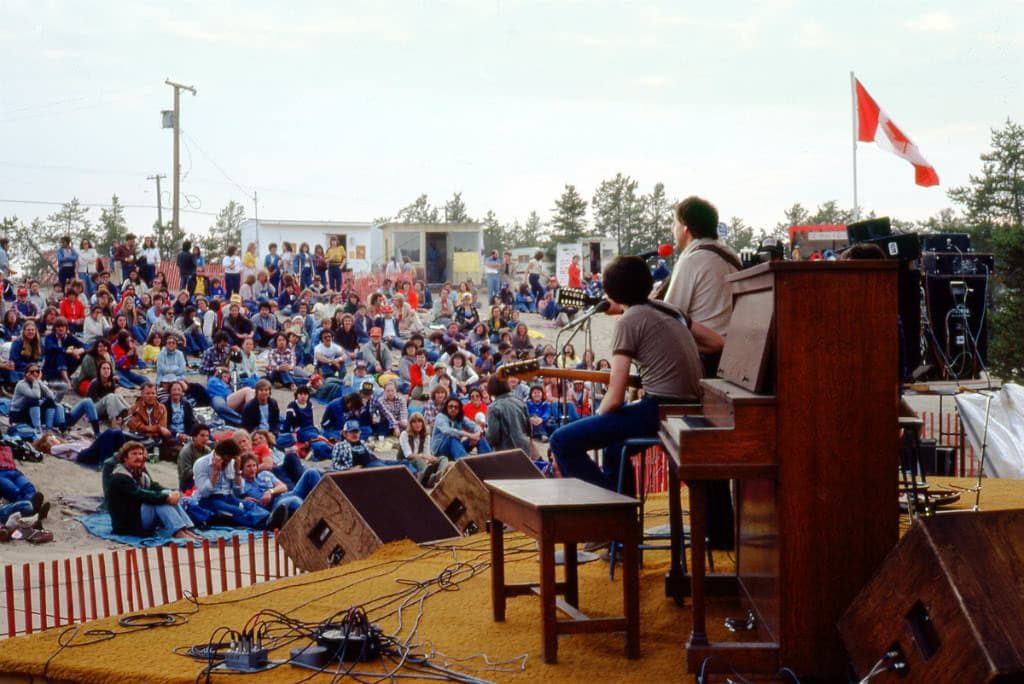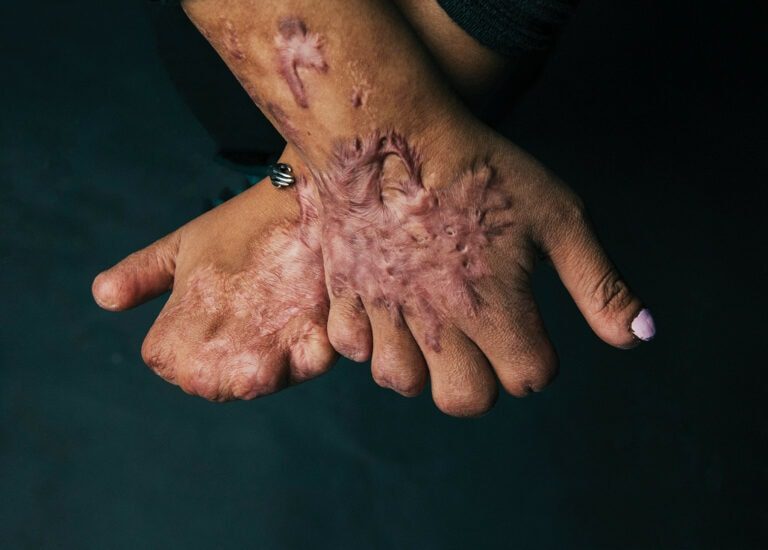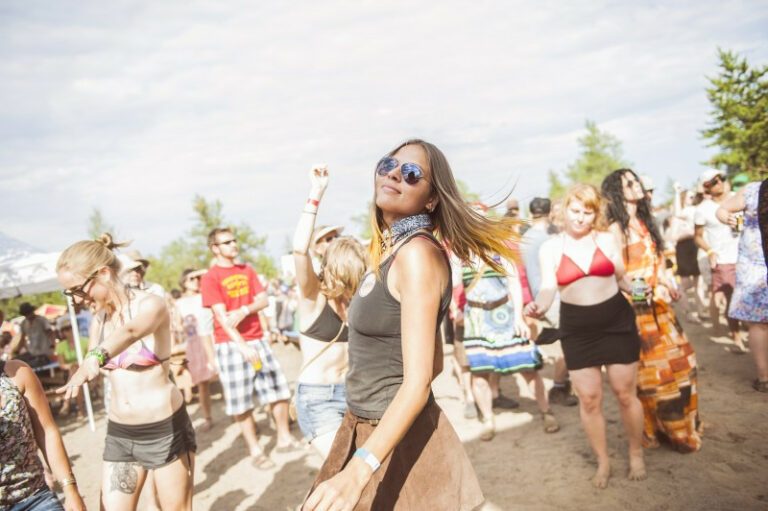Ever since it began, Folk on the Rocks has been a quirky, by-the-seat-of-its-pants festival filled with miracles and misadventures. Each year, organizers and participants have ended the weekend filled with a feeling of disbelief – “I can’t believe we pulled it off.” It’s always been, above all else, an endorsement of the shared ideals of folk music and community. But to some, it’s also just another reason to party. It’s a music festival, after all.
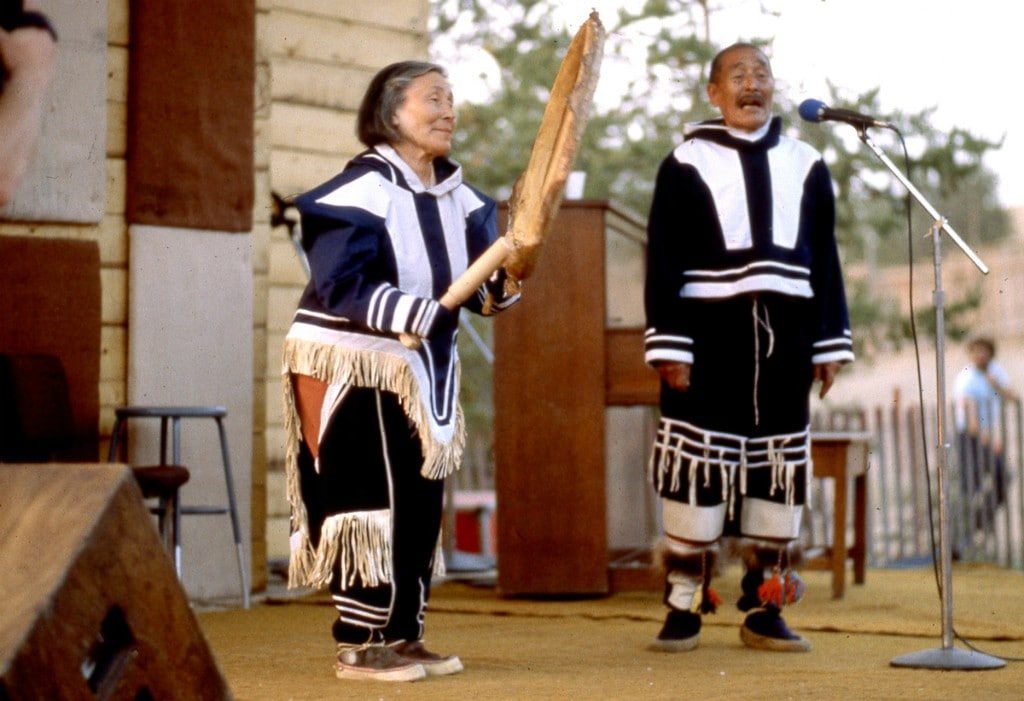
Nellie and Jimmy Hikok, 1980
First-year follies
Amanda Mallon recalls that at the first-ever festival “there was a biker’s bus at the far end of the gate. They had a big pig roast and probably illegal, nefarious things going on.
“We might’ve been paranoid – and one of the things that sort of floated around, I don’t know exactly, but we figured there were gonna be a lot of narcs there, a lot of of RCMP. And there was a whole row of plainclothesmen: We are here, we are not doing anything but we want to let you know that we are here. And they kind of just disappeared.”
Terry Woolf on covering the first day of the festival for the CBC: “The first thing you do is scout your location. So I got the CBC Suburban and drove out to the site. I stopped at a half-built stage, but couldn’t see anyone. I yelled and honked the horn and finally a guy named Bernie came cautiously from behind a shed. He was kind of nervous and stood well away from me. He squinted at the CBC vehicle, then yelled toward the shack, ‘It’s okay, it’s just the CBC.’ In those days CBC vehicles were painted deep blue, exactly like the RCMP Suburbans. As I moved toward the shack the smell of burning greenery gave me clue as to the problem.”
Terry didn’t know what to expect: “Could be Woodstock North, or it could be a bust… I remember being sweaty, bug-bit and covered in sand thinking: ‘It’s for the glamour. I’m working in TV for the glamour.’”
The finale featured Joe Mock, Rick Scott and Shari Ulrich. Everyone got up to dance, but: “unfortunately, someone thought that it would be easier to dance on sheets of plywood laid on the sand. These acted like huge bellows as people danced. So as the sun sets, all the folkies disappear in a blinding, choking fog of sand.”
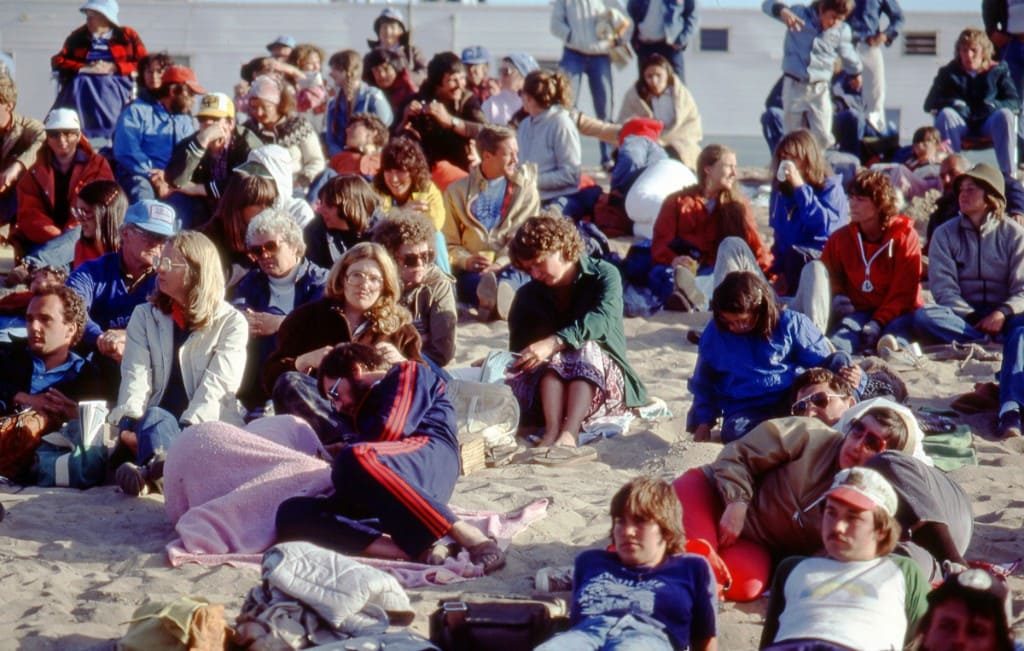
Ready to folk, 1980
Globalization
Each year, FOTR strived to become bigger and better. At one point it began to introduce international artists to the northern scene. Brian Latham recalls being particularly fascinated by Japanese troupe Azumi Taiko: “Taiko just means big drum,” and that’s what they played. “A Romanian band brought stuff to sell. They had leather slippers that they made that would pay their way to get there.”
Nancy MacNeill describes an on-stage collaboration with international artists and locals (a regular event at the festival): “One of my favourite finales of all time – it was so cool – was probably 2004, 2005 or something like that. It was the year that St. Pat’s High School started a STOMP club, basically inspired by the musical .
“We had the STOMP kids and then we had this African drumming band, and there was a lot of interesting rhythms with that, the Aurora Chorealis, they had learned a whole bunch of African songs and then, of course, the Dene drummers were performing too and it was just a really awesome, intense, multi-cultural, rhythmic finale and I loved it. There was just so much drumming and amazingness happening.”
Amanda Mallon billeted performers in the first years. One year, she had a group stay in her back shed: “Everyone was exotic: there was the fire-eater who stuffed swords down his pants. Njacko Backo was this cerebral presence. He was very very cool. On the last night, there was a performer’s party. And each performer’s flight was scheduled for seven in the morning the day after. So most of them partied and at some point went back to their hotel room or their billet. Njacko Backo got back to my place. He was so gently wonderfully drunk. And my boyfriend, my partner, Buddy, he was up every morning to go off to work. Well, when he got up to go to work, Njacko Backo grabbed him and gave him a big kiss on the cheek!“

The first festival’s site map
Beginnings
Folk on the Rocks helped a lot of artists get their start. Leela Gilday talks about her first year:
“In the beginnings of the festival, they would hold local auditions to get a spot. I was eight years old and, in addition to singing with my dad’s choir at the festival, I wanted to perform some solo tunes.
“At the audition, I forgot almost all of the words to my song – which was One Tin Soldier by Dennis Lambert and Brian Potter – but the cuteness factor landed me a place on the main stage. I was nervous at the show, since the audience was about 500 people (the largest show I had played at that time) but I made it through the two songs without forgetting lyrics. It was an exciting experience.”

Four-legged folk fan, 1980
Smoke on the Rocks
Nancy MacNeill: “Obviously last year was a really bad forest fire year. This year is too. But it was probably like 1998, 1999, whenever The Killjoys came – there was like a ton of smoke that year and there might have been an eclipse, or something?
“Anyways, The Killjoys were performing at mainstage, on a Saturday or a Sunday afternoon. And they actually stopped their performance to make everyone look at the sky because the sun was glowing bright red. And it looked so cool, it was so friggin’ beautiful. The whole sky was orange, the sun was just like this huge red circle. Really ominous and scary and very reminiscent of last year’s orange apocalypse.”
Flyover
Amanda Mallon: “There was a young woman performing, from out east, the Maritimes. She was on the stage singing a sweet folk song and you could hear an airplane taking off on the runway and you knew it was one of the big ones. You could hear it thundering up on the runway. I was lying on the sand on my stomach and this plane buzzed FOTR. I was as low as I could go and I still tried to press myself into the sand – that’s how low it flew over us. And the young woman singing on the stage just freaked and hit the the ground, that’s my memory of her. I think it was one of Buffalo Joe’s pilots, and I think it was kind of like, ‘I hope you guys realize we’re working while you guys are down there watching music.’ It wasn’t appropriate at all. But it was hilarious.“

Charlie Bolt and Colin Adjun, 1980
Mishaps
In the early years, the festival would get rained out (though that hasn’t happened for decades now – cross your fingers). Fran Hurcomb remembers one particular year when she wasn’t in attendance: “I remember listening to it back in the ’80s, way out on the lake. We got the CBC feed and they were recording live and they got hit by lightning. During the feed, it was quite exciting. All of a sudden you hear this ‘ka-bam, look out!’ and then static and then nothing! That was it! We didn’t hear until we got back into town a few days later. No one was hurt, [but] they had to take the whole thing indoors.”

Ken Bloom, 1980
Magic
Nancy MacNeill: “There was the time that this family entertainer called Mortal Coil came. They got dressed up like huge insects. They were wearing these big sequinned dragonfly and butterfly and bee costumes and they walked around on stilts. So they were all 10, 12 feet high. The kids just followed them around all weekend long and just adored them. But one of the Saturday or Sunday closing night sets in the beer garden, the Mortal Coil performers wandered in and they started dancing – like these 12-foot iridescent butterflies – started dancing with all the drunk people in the beer garden. And then they got up on the picnic tables and started twirling around like mad people, and everyone went completely bananas.”

Stompin’ up some sand clouds, 1980
Family Times
Marino Casebeer introduces his daughter, 14-year-old Shiri MacPherson, who’s been volunteering at FOTR her whole life. “She started hanging out here when she was five or six. We’d come out on Friday night, and she would be helping the vendor guy and riding on the quads. That’s why she became a rover the first time around, because of her interest in quads.
“During the school year, Shiri is so busy, we might see each other six hours a week. So [volunteering at FOTR] is a precious time. We’re not in each other’s faces because she paints and I do more construction, but we still take breaks together. Last year the new executive director started having barbecues for the work crews; that gave it more camaraderie.
“Many people did it for the same reasons as we did. It was a family event. Family was bigger in those days as well. We would have one or two families join together to form a work crew. But now it’s a struggle. It’s always a rush with volunteers. But back in the day it used to get filled by April.”
Nancy MacNeill: One of my favourite musical performances, ever, ever, ever, was Fred Penner a few years ago. He performed in the kid’s tent. It was an absolutely packed show. That place usually has 20 or 30 kids there for the audience. And by the time my sister and I got there, there were like 150 people crammed in around these tiny little children’s benches and picnic tables. Just standing, literally, in the bushes. These little kids who have probably never heard of Fred Penner, they’re sitting up at the front going “What is going on?”
Everyone was singing along to everything, and he invited people up to sing “Puff the Magic Dragon” and that kind of thing. The best moment for me was when he did “The Sandwich Song.” There were literally 150 grownups standing there screaming “Sandwiches are beautiful! Sandwiches are fine! I like sandwiches! I like them all the time!” Everyone was singing. it was so friggin’ good.”

Haunak Mikigak and Timangiak Petaulassie, 1980
Good Times
Nancy MacNeill: “There used to be after-parties down in the hospitality section. And those are always a good time. Always fun. They always ended up moving somewhere else too. One year, the musicians were down, and I don’t remember what the band was called but it was one of Wade Carpenter’s bands. He was, I think, playing fiddle… Someone was playing fiddle, someone in the band was playing fiddle. So there was 20 of us and we were just standing around in the kitchen shack and we ended up having this huge jigging contest to the fiddle music, and it was just awesome. We almost broke the floor just stomping through it. We didn’t know how to jig properly, we just improv’d it and had a great time.”
Henry Beaulieu, 1980
Growing pains
Fran Hurcomb: “The type of music changed for sure. It was FOTR and it was really folk music. Sometime around the ’90s, I guess, I think they decided they needed to get some more younger people out, so they brought in some band that was really popular with young people at the time. It was hardcore rock or whatever. Everyone was quite shocked. They closed it down and they ended up with a whole bunch of 16-year-olds there and a bunch of adults going “Oh my god,” and just leaving. They had to iron out a few kinks after that. Now they’ve reached a nice balance where they kind of have something for everybody.
“I don’t remember there being such an emphasis on the booze. I don’t remember a big beer garden or anything like that. To me, that is sort of recent-ish. Maybe in the past 10 years. I’m not even sure there was even a license.”

Food vendor, 1980
Marino Casebeer: “On the water they put out floating docks. That just started last year. Part of the problem is we always have boat crashers. During the festival, it’s like a boat parking lot, people just sit there and listen. Now that we have these docks they’ll come up to the docks and just pile off.
“Even with security checks smuggle in booze. Even if it’s fenced off, it’s fairly open, and people will come the week before and bury their booze around the site. Or even put it in the water.”
Aislinn Stirling: “Last year I was pretty disappointed to see that some people who were partying were leaving a big mess. Like bottles and garbage and stuff everywhere. I don’t think the tailgating has been a huge problem. But I’ve heard small things here and there, and it’s like ‘Why can’t you pick up after yourselves?’”

Joe Loutchan and David Essig, 1980
But …
Keith MacNeill: “It’s totally enchanting. One of the things that I’ve always loved about Folk is that people go there and come away with a new favourite band. And that speaks strongly for the way the selections people search for great performers, great musicians that don’t charge top dollar because we can’t afford a lot of those.
There’s a lot of southern performers who think, ‘I’ve never been to the North before, what could they possibly have way up there that would be a cool musical experience.’ Yet we always have bands coming back to us afterwards and saying ‘Your place, your festival, is magic.’”

